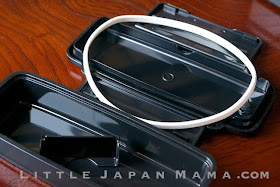... Did I mention feminine and cute??
"Flower River" features a very slightly translucent jelly-pink upper and lower box and divider, and a cherry blossom coloured (very pale pink) external (upper) lid with a playful flower design. Your bento was never so exciting as when it came in a colour which seemed to call "eat me!"
"Forest Color", with its nature-loving leafy design, has light yellow-green upper and lower boxes and end clips, with both external (upper) lid and internal lid in pure white. Lunch is a time to relax, and if you can't be physically surrounded by nature, you may as well have a bento box which lets you imagine it.
Each set includes:
- Lower box with internal lid which doubles as the chopstick compartment,
- Upper box with an airtight external lid with clips which snap shut on the ends of the lower box, holding it all tightly together,
- Internal divider - for the upper box, to keep your okazu separate and perfect
- A pair of matching 16.5cm chopsticks
- Matching lunch bag
The silicone seal in the external (upper) lid is excellent quality (passed my water leak test - details below) and easily removable for washing.
Size: M (This bento boxes is the perfect size for my bento lunch.)
Total 630ml : Lower box 330ml, Upper box 300ml (+ approx 100ml space under the lid)
Dimensions: 193x63x89mm
Freezer safe
Microwave safe for re-heating, only with both lids removed.
Upper and lower containers: PP Heat resistance: 140°C Microwave Safe
External (upper) lid: AS Internal lid: EVA (Lids not heat resistant, do not microwave)
Chopsticks: AS
BPA-free
Made in Japan by SKATER
.jpg)
I tested the upper lid seal by half-filling the upper box with water and shaking it upside-down. Completely dry. It didn't leak even a drop, which is more than I can say for a similar non-made-in-Japan bento box I tested. While I can't guarantee that the seal of your box won't leak under any circumstances - and I don't physically test every box I send out - so far for me, the upper compartment of this bento box has been 100% leak-free!
.jpg)
.jpg)
.jpg)
.jpg)
.jpg)
.jpg)

































